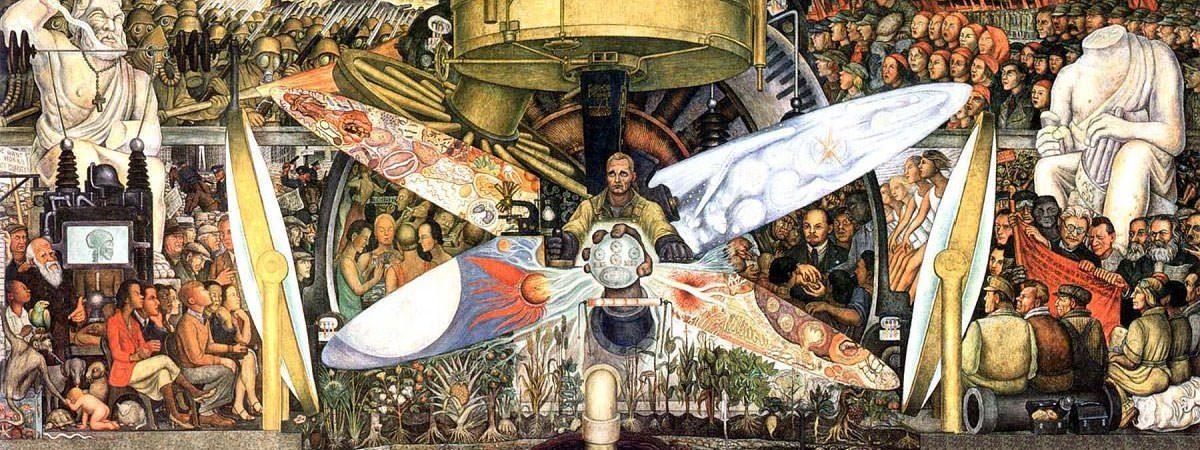Before the Spanish conquest in the 16th century, Mexico came under a region now known as Mesoamerica. Mesoamerican art was strongly based on nature, the surrounding political reality and the gods. After the Spanish conquest, art in Mexico was primarily used as a mean to propagate Christianity. However, after Mexico won its independence from Spain in 1821, the nation’s art featured the heroes of its independence; and indigenous themes began to appear in paintings and sculptures. The Mexican Revolution, which took place from 1910 to 1920, radically transformed Mexican culture; and it had a deep and profound affect on Mexican art. The Mexican muralism movement then dominated the Mexican art scene; and from 1920s to 1970s, numerous murals with nationalistic, social and political messages were created on public buildings. Mexican art has continued to evolve with artists exploring unfamiliar territories and carving out their own identity separate from European influences. Here are the 10 most famous paintings by Mexican artists.
#10 Echo of a Scream
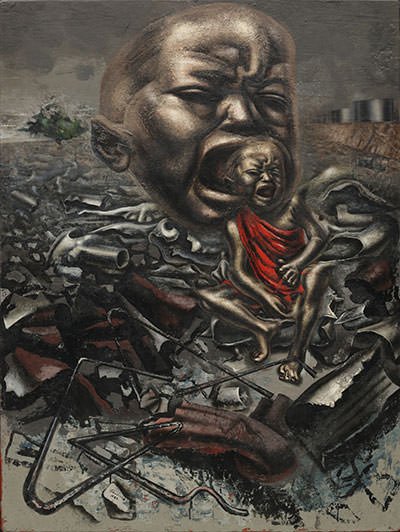
| Spanish Title: | Eco de un grito |
| Location: | Museum of Modern Art, New York City |
| Artist: | David Alfaro Siqueiros |
| Year: | 1937 |
Along with Diego Rivera and José Clemente Orozco, David Alfaro Siqueiros is regarded as one of the “los tres grandes” (three greats) of Mexican muralism. The most radical of the three, Siqueiros is renowned for his depictions of human struggle against authoritarian regime. His most famous work, Echo of a Scream depicts the bleakness, despair and destruction of war. Painted at the time of the Spanish Civil War, it is a captivating work which visually and metaphorically captures human suffering during war. The most prominent figure in the painting is an enlarged head of a crying baby and another crying baby is coming out of his mouth. Among other things, shells, broken canons and shrapnel are spread on the ground portraying the fallout of war. Echo of a Scream is one of the most famous Mexican antiwar paintings.
#9 Three People
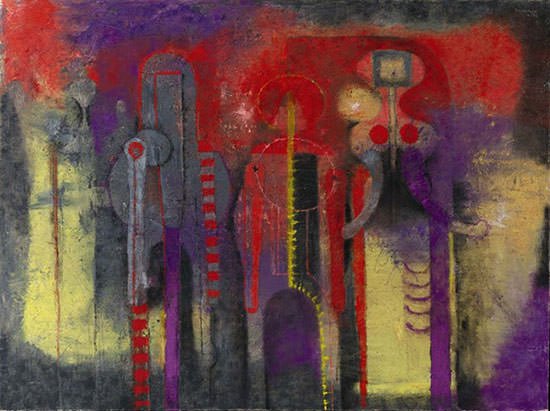
| Spanish Title: | Tres Personajes |
| Location: | Private Collection |
| Artist: | Rufino Tamayo |
| Year: | 1970 |
Tres Personajes is the best known work of Rufino Tamayo, who is regarded as one of the greatest Mexican painters of the 20th century. A masterpiece of abstract art, this painting depicts a man, a woman and an androgynous figure. Tamayo has used his signature rough surface texture, made of sand and ground marble dust mixed into the paint. Also, vibrant shades of purple, orange and yellow have been employed to add splendor to the painting. In 1977, Tres Personajes was bought by a resident of Huston, Texas for his wife at a price $55,000. The painting was stolen in 1987 but was found in 2003 by a New York resident who received a reward of $15,000 USD.
#8 Self-Portrait: The Inn of the Dawn Horse
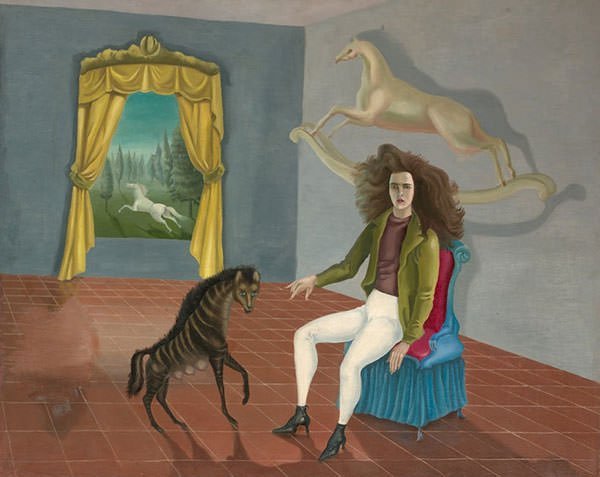
| Spanish Title: | La posada del Caballo del Alba |
| Location: | The MET, New York City |
| Artist: | Leonora Carrington |
| Year: | 1938 |
Considering that renowned Mexican painter Frida Kahlo declared that she was not a Surrealist, Leonora Carrington is perhaps the most famous female Surrealist artist. Unlike the other Surrealists, Carrington was not interested in the writings of Sigmund Freud. She is instead famous for her haunting, autobiographical paintings that incorporate images of sorcery, metamorphosis, alchemy and the occult. This self-portrait, also known as The Inn of the Dawn Horse, is her most acclaimed work. In it, she has painted herself posed in the foreground on a blue armchair with her hand pointing toward a female hyena. A white rocking horse appears to float on the wall behind her head while a white horse gallops freely in the window in the background. The distorted perspective, the mysterious narrative and autobiographical symbolism of this portrait perhaps demonstrate the artist’s attempt to reimagine her own reality.
#7 Detroit Industry Murals
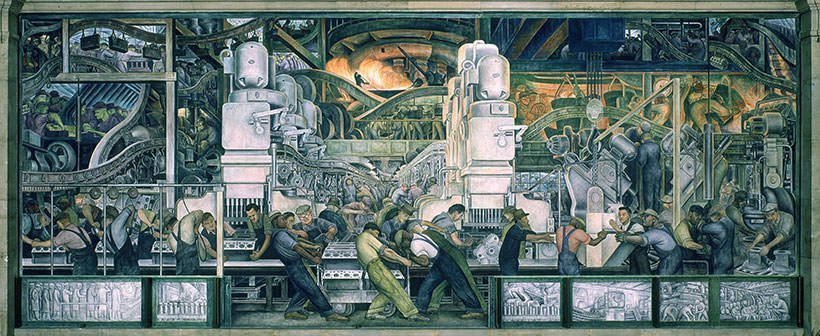
| Spanish Title: | Murales de la industria de Detroit |
| Location: | Detroit Institute of Arts, Detroit, Michigan, U.S. |
| Artist: | Diego Rivera |
| Year: | 1933 |
Considered a genius who could turn his hand to any style including Impressionist, Post-Impressionist, Cubist and Flemish, Diego Rivera believed that everyone should be able to view his art and hence he painted large murals on public buildings. In 1932, he was commissioned to paint twenty-seven frescoes in the Detroit Institute of Art in Midtown Detroit, Michigan, US. From the 27 murals that Rivera painted, the two largest murals are located on the north and south walls. They depict laborers working at Ford Motor Company’s River Rouge Plant. Other panels depict advances made in various scientific fields, such as medicine and technology. Rivera considered the Detroit Industry Murals to be his most successful work. In 2014, the murals were given National Historic Landmark Status.
#6 The Broken Column
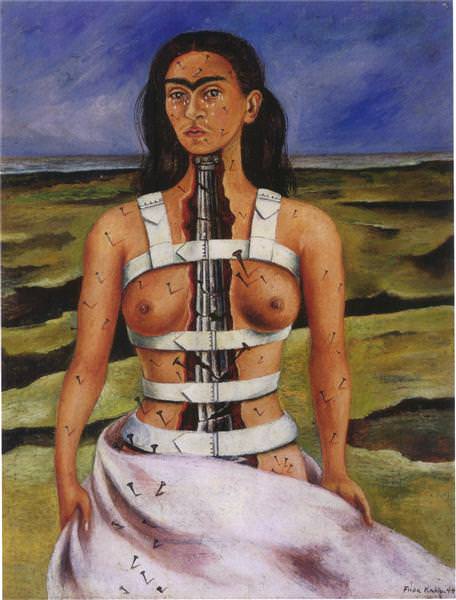
| Spanish Title: | La Columna Rota |
| Location: | Museo Dolores Olmedo, Xochimilco, Mexico City |
| Artist: | Frida Kahlo |
| Year: | 1944 |
On 17th September 1925, Frida Kahlo and her friend Alex were riding in a bus when it crashed into a street trolley car. Due to the grave injuries she suffered in the accident, Frida had to undergo 35 operations in her life, bear with relapses of extreme pain and could not have children. Kahlo’s works often depict the trauma she had to go through in her life and this work is the most conspicuous portrayal of her suffering. In this masterpiece Kahlo’s body is opened up and a crumbling stone column replaces the spine of Kahlo, symbolizing the consequences of the accident. Nails are stuck into her face and body and tears can be seen on her face but she looks straight at the viewer. The Broken Column is the most straightforward and ruthless depiction of the agony Kahlo faced through her life.
#5 Man at the Crossroads
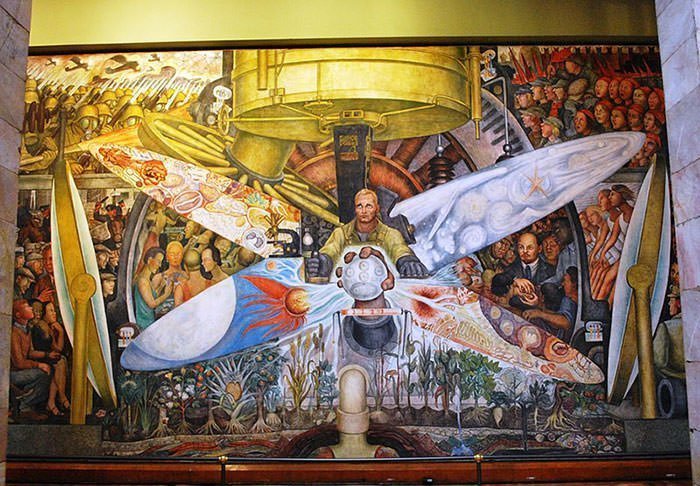
| Spanish Title: | El Hombre en la encrucijada |
| Location: | Palacio de Bellas Artes, Mexico City |
| Artist: | Diego Rivera |
| Year: | 1934 |
This fresco was first commissioned by the Rockefellers for ground-floor wall of Rockefeller Center in New York City. However it couldn’t be completed as Rivera refused to remove a portrait of Lenin which was causing a controversy. It was subsequently destroyed but Rivera had black-and-white photographs of it. Using these, he recreated a nearly identical mural at the Palacio de Bellas Artes in Mexico City. It was renamed Man, Controller of the Universe. At the center of this masterpiece is a workman controlling machinery with a fist holding an orb in front of him. 4 propeller-like shapes stretch from center to corner of the composition representing discoveries made possible by science. The composition also depicts a contrast between Capitalism and Socialism with wealthy people playing cards and smoking in the left while on the right Lenin is seen holding hands with a multi-racial group of workers. Man at the Crossroads is definitely the most renowned masterpiece by Diego Rivera.
#4 La Calavera Catrina
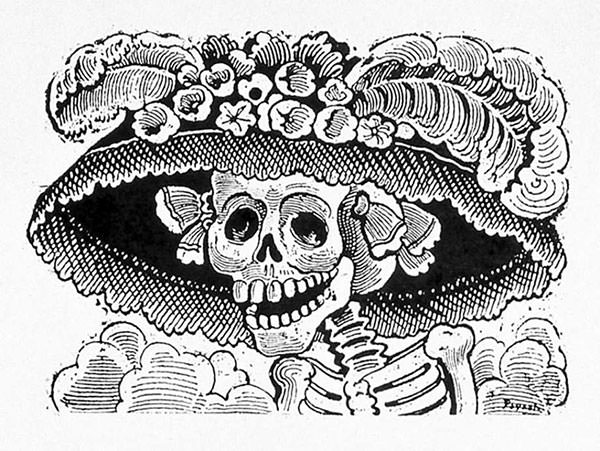
| English Title: | The Elegant Skull |
| Artist: | José Guadalupe Posada |
| Year: | 1913 |
José Guadalupe Posada is considered a hugely influential political printmaker and engraver due to his satirical acuteness and social engagement. His most famous work, La Calavera Catrina depicts a tall, elegantly attired female skeleton wearing an extravagantly decorated hat. The portrait is considered a satirical depiction of those Mexican citizens who were ashamed of their indigenous origins and instead aspired to adopt European traditions. The Day of the Dead is a popular Mexican holiday in which family and friends gather and remember those who have lost their lives. La Calavera Catrina has become an icon of the Day of the Dead and it is common to see her embodied as part of Day of the Dead celebrations throughout the country. Now a part of Mexican culture, La Calavera Catrina is inspired from Mictecacihuatl, the Aztec “goddess of death and Lady of Mictlan, the underworld.”
#3 Self-Portrait with Thorn Necklace and Hummingbird
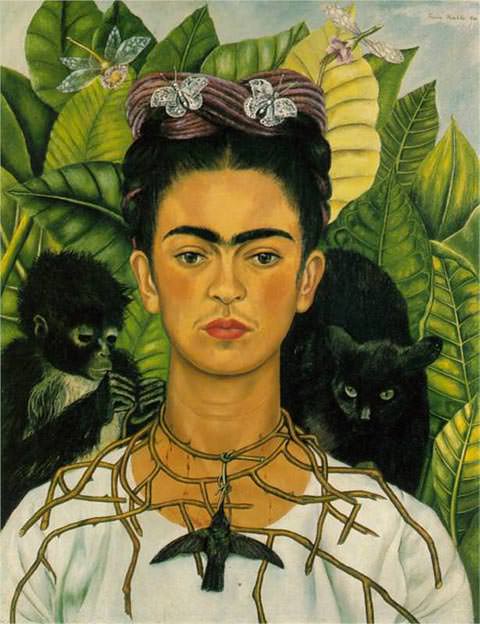
| Spanish Title: | Autorretrato con Collar de Espinas |
| Location: | Harry Ransom Center, Austin, Texas, U.S. |
| Artist: | Frida Kahlo |
| Year: | 1940 |
Frida Kahlo is known for symbolically portraying her physical and psychological wounds through her self-portraits and this painting is a prime example of that. In it Kahlo is wearing a thorn necklace and blood can be seen tricking from the wounds made on her neck by the thorns. A black monkey and a black cat are present on left and right side of her; and a hummingbird is hanging lifelessly from the thorn necklace. Kahlo identified herself with indigenous Mexican culture and this is apparent in the portrait. The black panther is symbolic of bad luck and death; the monkey is a symbol of evil; and the hummingbird, which is dead, is a symbol of freedom and love. The painting may be seen as placing Kahlo amid symbols of colonial and male repression. Self-Portrait with Thorn Necklace and Hummingbird is among Kahlo’s most celebrated masterpieces.
#2 Our Lady of Guadalupe

| Spanish Title: | Nuestra Señora de Guadalupe |
| Location: | Tepeyac Hill, Mexico City |
| Year: | 1531 |
According to legend, Blessed Virgin Mary appeared in Mexico before a 57-year old peasant named Juan Diego, who was an Aztec convert to Christianity. She requested that a shrine to her be built on the spot. However, the archbishop asked for proof. When Juan Diego returned to Mary and told her this, she instructed him to climb to the top of the hill and gather flowers. At the top of the hill, Juan Diego found Castilian roses, which were neither in season nor native to the region. Virgin Mary arranged the flowers herself in Juan Diego’s tilma (a burlap-type cloak). She then told Diego to open the cloak only upon his return to the bishop. When Diego did so, the flowers fell to the floor and left on the surface of the tilma the image now known as Our Lady of Guadalupe. The image is now enshrined within the Minor Basilica of Our Lady of Guadalupe in Mexico City. Our Lady of Guadalupe has become a national symbol of Mexico and it has made the basilica the most visited Catholic pilgrimage site in the world.
#1 The Two Fridas
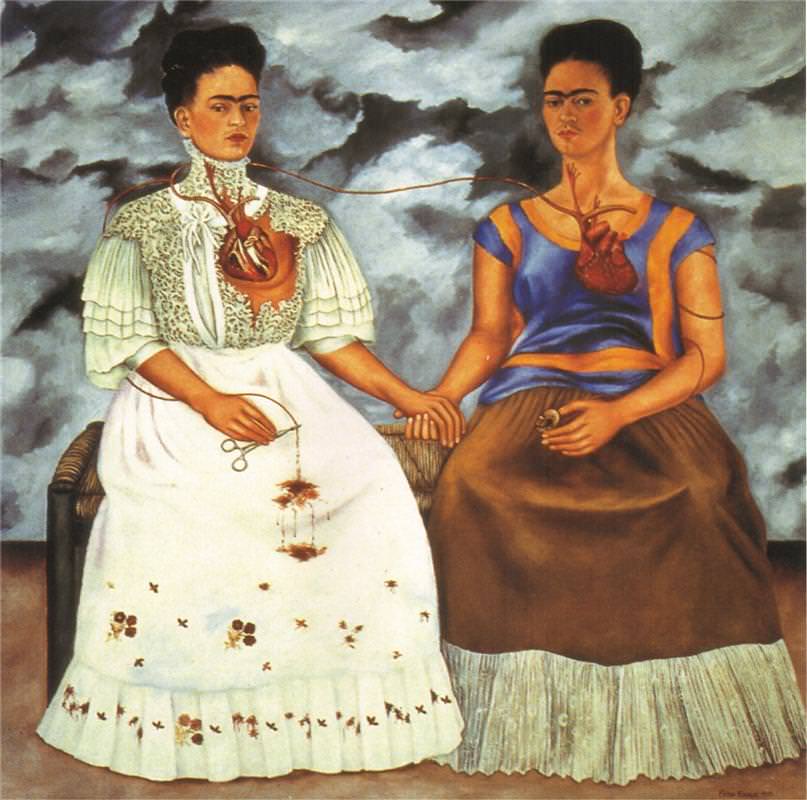
| Spanish Title: | Las dos Fridas |
| Location: | Museo de Arte Moderno, Mexico City |
| Artist: | Frida Kahlo |
| Year: | 1939 |
Frida Kahlo is the most famous Mexican artist and one of the greatest artists in self-portraiture of all time. She had a tumultuous relationship with another famous Mexican painter Diego Rivera during which they married, divorced and re-married. The Two Fridas was created around the time of Kahlo’s divorce to Diego Rivera and it is believed it portrays her loss. It is a double self-portrait. Frida on the left is wearing a white European style dress with her heart torn and bleeding while Frida on the right is wearing a traditional Mexican dress with her heart still whole. Kahlo remarried Rivera a year later and although their second marriage was as troubled as the first, it lasted till her death. Las dos Fridas is the largest work of Kahlo and it is perhaps the most famous painting by a Mexican artist.

